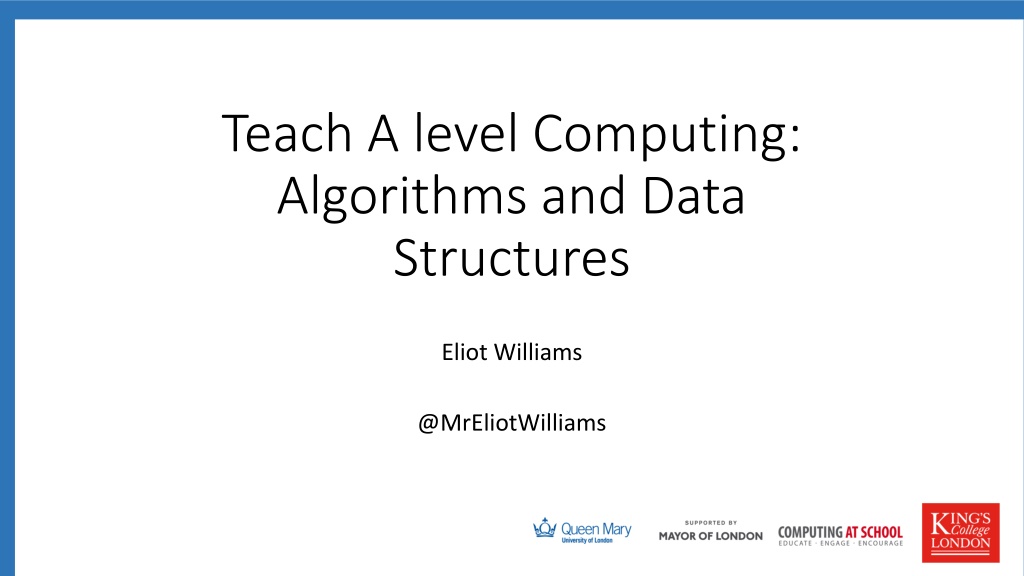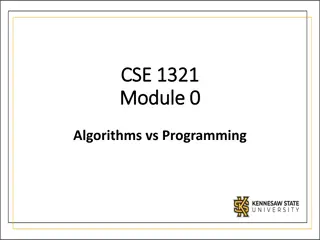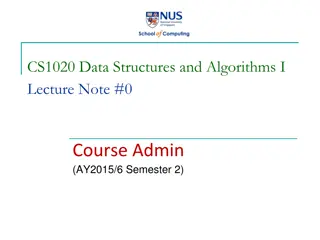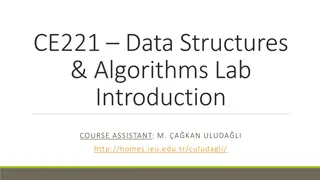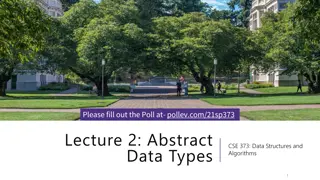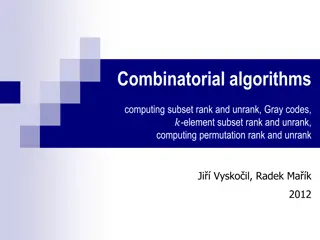Understanding Algorithms, Data Structures, and Programming in Computing
Explore the fundamentals of algorithms and data structures in computing, including representations of data structures, recursive algorithms, searching and sorting techniques, hashing, dictionaries, graphs, trees, and more. Dive into the complexities of data types, abstract vs. built-in types, simple/primitive data types, lists, and strings. Gain insights into how these components play a crucial role in programming and problem-solving.
Download Presentation

Please find below an Image/Link to download the presentation.
The content on the website is provided AS IS for your information and personal use only. It may not be sold, licensed, or shared on other websites without obtaining consent from the author. Download presentation by click this link. If you encounter any issues during the download, it is possible that the publisher has removed the file from their server.
E N D
Presentation Transcript
Teach A level Computing: Algorithms and Data Structures Eliot Williams @MrEliotWilliams
Course Outline 1 Representations of data structures: Arrays, tuples, Stacks, Queues,Lists 2 Recursive Algorithms 3 Searching and Sorting - EW will be late! 4 Hashing and Dictionaries, Graphs and Trees 5 Depth and breadth first searching ; tree traversals
Data structures are complex data types Allow you to store multiple data items of one or more data types . a mechanism for grouping and organizing data to make it easier to use. Data structures can be made from multiple data types and other data structures
Abstract vs Built in Abstract Data type A model of how a data is stored and what operations can be carried out on the data Built in Type A predefined implementation of a data type in a programing language
Simple/Primitive data types Boolean Int Float Char (python doesn t really have chars) Define how a fixed length binary code should be interpreted by a program
Lists Lists are a complex and powerful data structure. Very easy to use in python What are the properties of a list?
Lists Lists are a complex and powerful data structure. Very easy to use in python mylist=["sausages", "tin of beans", "eggs , 10] mylist[0] ="6 sausages" mylist.append("mushrooms") print(mylist) mylist.remove("tin of beans") print(mylist)
Lists Lists are a complex and powerful data structure. Very easy to use in python List are mutable Lists have variable length Lists are ordered. Constituent parts can be of different sizes and data types. Hard to understand how they work though so we will look at some simpler data structures first .
Strings Built in data structure made up of? Properties of a string Mutable? Ordered? Fixed length?
Strings Built in data structure made up of? Properties of a string Immutable Ordered Fixed length Component parts all the same size So not a list .
Arrays Simple data structure built in many languages(not python) One variable that can contain multiple items of the same type that are held in consecutive memory locations 0 1 2 3 4 5 6 7 8 Grade 20 80 50 60 70 55 92 60 85 We can access parts of an array by indexing e.g. Grade[0] Accessing any element takes the same time.. Arrays have fixed length Arrays are mutable a component value can be changed e.g. Grade[0]=90
Arrays vs list Arrays Lists Fixed number of entries Can be extended All entries the same size Continuous in memory Can have different entries more complex mutable mutable Arrays are a simple data structure which are Easy to understand how it works Very efficient. Accessing any element takes the same time . Allow us to create more complex data structures from them
Arrays vs Strings Arrays Strings Fixed number of entries Fixed number of entries All entries the same size mutable All entries the same size immutable
tuples Print teacher A tuple is a finite ordered list of elements. Tuples are sometimes referred to as records Elements is a tuple can be of different data types. teacher = ( Mr , Eliot , Williams ,1978) Will return the contents separated by commas Print teacher[2] will return Williams Eliot Mr 1978 Williams Tuples are ordered, fixed length & immutable
Tuple uses Collecting together data about one thing Record Returning multiple values from a procedure Write a function takes an input of a radius that returns a tuple of both the area and the circumference of the circle:
unpacking tuples (python only) teacher1 = ( Mr , Eliot , Williams ,1978) (title,first,surname,year)=teacher1 print (surname) This also allows us to swap the contents or variables easily (a,b)=(b,a)
Multidimensional arrays (NB using lists) Names Bob Sally James Names =[ Bob , Sally , James ] Mark1=[20,23,19] Marks2=[21,22,20] Marks3=[19,23,20] Mark1 20 23 19 Mark2 21 22 20 Mark3 19 23 20 Could be created as Names =[ Bob , Sally , James ] grades=[[20,23,19],[21,22,20],[19,23,20]]
Names Bob Sally James Mark1 20 23 19 Mark2 21 22 20 Mark3 19 23 20 grades=[[20,23,19],[21,22,20],[19,23,20]] How could we access Bob s score for test1? How could we work out Bob s total score? How could we work out the average for test3?
Names Bob Sally James Mark1 20 23 19 Mark2 21 22 20 Mark3 19 23 20 grades=[[20,23,19],[21,22,20],[19,23,20]] How could we access Bob s score for test2?
Names Bob Sally James Mark1 20 23 19 Mark2 21 22 20 Mark3 19 23 20 grades=[[20,23,19],[21,22,20],[19,23,20]] How could we access Bob s score for test2? grades=[a,b,c] grades[1] >>>>>b>>>>[21,22,20] b[0]>>>>21 grades[1][0]
Names Bob Sally James Mark1 20 23 19 Mark2 21 22 20 Mark3 19 23 20 grades=[[20,23,19],[21,22,20],[19,23,20]] How could we work out Bob s total score? Score =grades[0][0]+grades[0][1]+grades[0][2] but this might take a long time to type if there were lots of tests Score=0 For i in range(0,3): score=score + grades[0][i]
Names Bob Sally James Mark1 20 23 19 Mark2 21 22 20 Mark3 19 23 20 grades=[[20,23,19],[21,22,20],[19,23,20]] How could we work out the average for test3? Average=(grades[2][0]+grades[2][1]+grades[2][2])/3
Multi Multi- -Dimensional Array Dimensional Array Tasks Tasks Sum Columns of Table (page 1)
We can have n dimensional arrays Marks[test][question][person] [[[3,5,7],[
Stacks & Queues Abstract data types - ordered collections of data Queue Last In First Out Stack First In, Last Out
Top of Stack Stacks Bob Dave 2 stack operations Push puts data at the top of the stack Top of Stack Bob Dave James Pop removes data from the top of the stack and returns it Top of Stack James Bob Dave
Stack Exercises Theory p2 Practical P3
Python list commands. list.append() list.pop()
Queue Data enters a queue from the back Data leaves a queue from the front Dave John Paul Dave John John Dave Paul
Implementing queues Very similar to a stack We could use a fixed length array Dave John 2 operations Enqueue Add an item into the queue Dequeue Remove the first item in the queue move all items up?
Queue Exercise (page 4) Write two procedures enqueue #put the item at the back of the queue # change back of queue value dequeue #return first value #update rest of queue.. all errors should be appropriately handled Queue and backofqueue may be used as global variables in this assignment easy, medium and hard code skeletons are available
Priority Queue Some things are more important than others! Items should be dequeued in order of priority then queue position Several ways of doing this:
Priority Queue Some things are more important than others! Items should be dequeued in order of priority then queue position Several ways of doing this: Change enqueue to put things in the right place! Lots of data shuffling, inefficient in an array based structure Change dequeue to find the high priority items first
Priority Queue- Dequeue queue=[("bob",1),("James",1),( David ,2),( John ,1),"","","","","",""] backofqueue=2 dequeue(): loop through the queue to find the highest priority and its position store the value at that position move all the items from that point up down one update and clear back of queue return stored answer
All this shuffling data about is wasteful We could just move a pointer Front Back Bob Ed Cara Dave
Priority Queue Exercise (p5) Write the dequeue procedure dequeue #find the highest priority item in the queue and return it, #update queue all errors should be appropriately handled Queue and backofqueue may be used as global variables in this assignment easy, medium and hard code skeletons are available
Circular Queue Back Front Gloria Henry Fred Dave Eve Pointer movement for enqueue and dequeue needs to wrap round How do we tell if a queue is full? How do we tell if a queue is empty? Eve Fred Dave
If head = tail then the queue is defined to be empty if head = tail + 1, or tail = max and head = 0, it is defined to be full. Back Front Eve Fred Alice Bob Cara Dave
Lists Variable size Mutable ordered
Linked Lists An implementation of the list abstractions
Linked List Concept b c d e f front back Each entry has A value A pointer to the next entry Keep a pointer to the front entry The pointer of the last entry is None
We could represent this in python by list=[['James',2],['Bob',0],['Sarah',-1]] startpos=1 length=3 We would need procedures to find a values position Find an pointers position Add Delete (and update the previous pointer using find a pointer) Print in order Insert a new value
Exercise b c d e f front back Redraw list after: appending a new entry at the end inserting before entry zero inserting before entry 3
Linked List Index myList.index(i) Count along the list to entry i Return the value pointer = front count = 0 while count < i: pointer next of current entry count = count + 1 return the value of current entry
Linked List Update myList.update(idx, newValue) Count along the list to entry index Replace value with new value pointer = front count = 0 while count < idx: pointer next of currentEntry count = count = 1 currentEntry.value = newValue
Linked List Insert myList.insert(idx, newValue) Count along the list to entry idx-1 Insert a new entry Next pointer of current entry points to new entry Next pointer of new entry points to following entry
